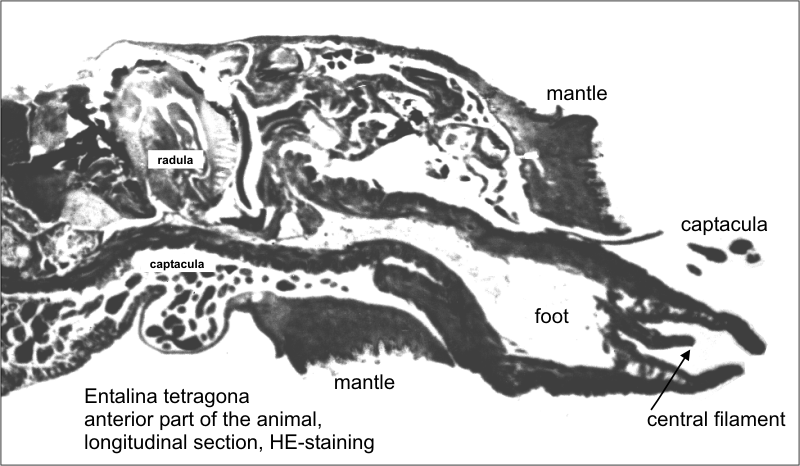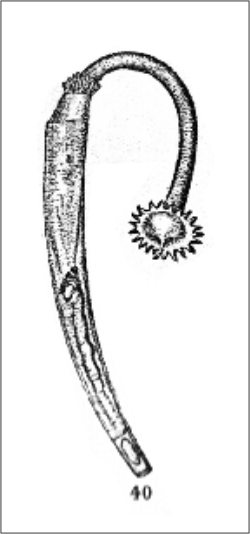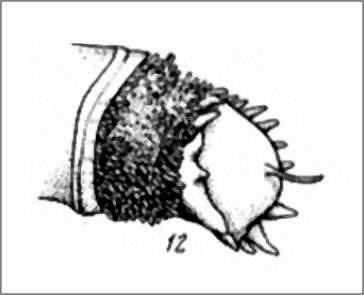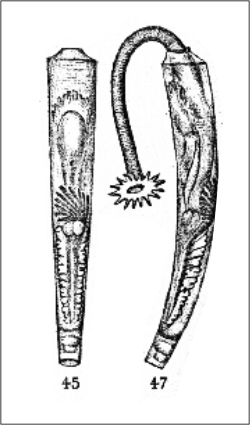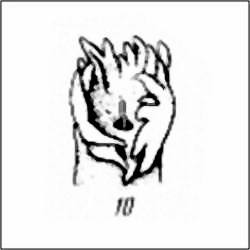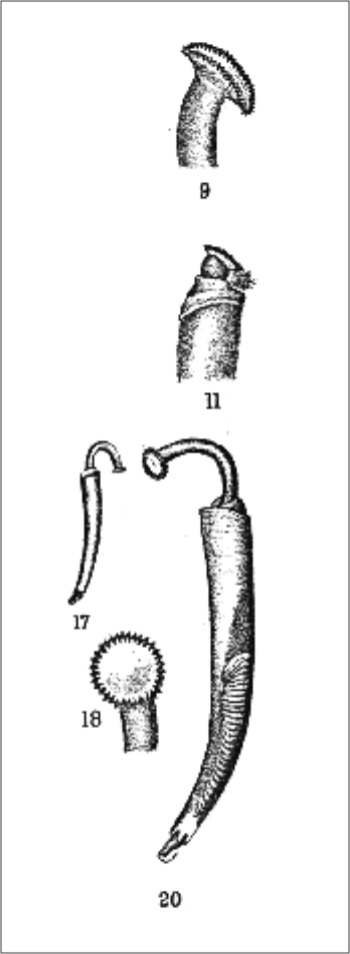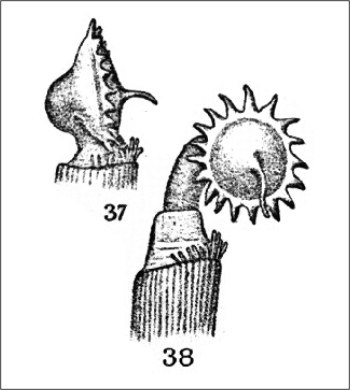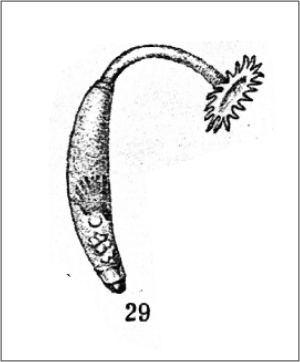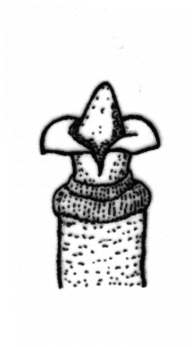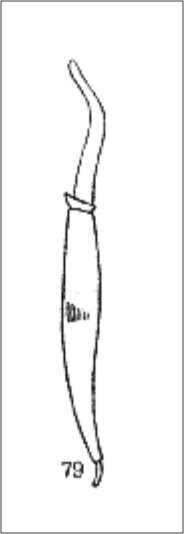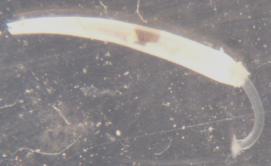|
|
|
 |
 |
|
Some reflections about the foot of the non dentaliid scaphopod molluscs
Bernd Sahlmann, Munich, 01/2005
The foot of the scaphopod animal in the order Gadilida seems to have a disc shaped termination in most (or all?) cases, quite distinctive from the typical boat like (scaphoid) foot of Dentalium sl with its two epipodial lobes (Fig. 1).
The type species of Entalina (Entalina tetragona Brocchi 1814) (Fig. 2, 3) and Pulsellum (Pulsellum lofotense M. Sars 1865, Fig. 4) possess an additional central finger shaped appendix to the pedal disc (Sars 1865). According to the figures given by Sars (1865) the central appendix is missing in Pulsellum affine (Fig. 5) as well as in Striopulsellum galatheae (animal figured in Knudsen 1964).
Some histological findings on Entalina can be found in the thesis of Sahlmann (1973). The figures from Chistikov (1982a,b) show that Costentalina tuscaroae (Fig. 10) and Spadentalina tubiformis (Fig. 11) display the typical foot of Entalina ss as well as Entalina pentagona (Chistikov 1982c).
No information is available on the genus Annulipulsellum and Compressidens. Siphonodentalium has a disc shaped foot without filament as pictured for its type species Siphonodentalium lobatum Sowerby 1860 by Sars (1861, Fig. 6). Steiner (1992) in his cladistic table states that all Gadilidae should have a filament.
Cadulus subfusiformis, according to Sars (1865, Fig. 7), has a disc shaped foot without central appendix as well as Cadulus (Polyschides) quadridentatus Dall (Davis 1968) and Cadulus (Siphonodentalium?) dalli antarcticus (Odhner 1931). The picture of Dischides politus Wood taken by Mifsud (1996, Fig. 8) shows a long slender foot with a terminal disc without central filament in this species.
Shimek (1989) states that Gadila aberrans Whiteaves 1887 has a caduliform foot “ with a terminal disk, and papillae laterally; sometimes one or two small papillae are visible on the distal face of the terminal disk”. Poon (1987) gives the information of a pedal disk in Gadila tolmiei Dall 1897 without comments on papillae and filaments, but gives the information that according to Shimek it may “capture foraminiferans with its pedal disk”.
Curiously the foot of Gadila clavata (Dentalium clavatum at original diagnosis) is described to be vermiform by its original author Stimpson (1865) (see figure 9). Simroth (1894) already pointed to this peculiar finding, but the animal has been never checked again. As there are no other similar findings in the Gadila up to now this observation gives some doubt to the assignment of this species to the order Gadila.
(to be continued)
|
 |
|
Literature:
Chistikov SD (1982a). Modern molluscs of the family Entalinidae (Scaphopoda, Gadilida). 2. Subfamiliy Heteroschismoidinae -2. Zool Zhur, 61(9): 1309-1321.
Chistikov SD (1982b). The modern Entalinidae (Scaphopoda, Gadilida). 1. Subfamily Heteroschismoidinae -1. Zool Zhur, 61(5): 671-682.
Chistikov SD (1982c). The modern Entalinidae (Scaphopoda, Gadilida). 3. Subfamily Entalininae. Zool Zhur, 61(10): 1492-1500.
Davis JD (1968). A note on the behavior of the Scaphopod, Cadulus quadridentatus (Dall) 1881. Proc. Malac Soc Lond, 38: 135-138.
Knudsen J (1964). Scaphopoda and gastropoda from depths exceeding 6 000 meters. Galathea Rep, 7: 125-136.
Mifsud C (1996). Living Mollusca from circalittoral coastal muds, off Western Malta. La Conchiglia, 28: 23-41.
Odhner NH (1931.) Die Scaphopoden. Further Zool Res Swed Antarct Exped 1901-03. 2(5): 1-10.
Pilsbry HA, Sharp B (1897-98). Scaphopoda. In: Tryon´s Manual of Conchology, Ser.1, 17:1-280.
Poon PA (1987). The diet and feeding behavior of Cadulus tolmiei Dall, 1987 (Scaphopoda: Siphonodentalioida). Nautilus, 101(2): 88-92.
Reynolds PD, Okusu A (1999). Phylogenetic relationships among families of the Scaphopoda (Mollusca). Zool J Linn Soc, 126: 131-154.
Sahlmann B (1973). Untersuchungen zur Histologie und Nahrungsbiologie der Scaphopoden. Thesis, Univ Kiel, 107 pp.
Sars M (1861). Om Siphonodentalium vitreum, en ny slaegt og art af dentalidernes familie. Christiania Universitets-Program for 1861. 29 pp.
Sars M (1865). Malacozoologiske Jagttagelser. II. Nye Arter of Slaegten Siphonodentalium. Forh Videnskab Selsk Christiania (Aar 1864), p.296-315.
Shimek RL (1987). Shell morphometrics amd systematics: a revision of the slender, shallow-water Cadulus of the Neorteastern Pacific (Scaphopoda: Gadilidae). The Veliger, 32(3): 233-246.
Shimek RL (1990). Diet and habitat utilization in a Northeastern Pacific Ocean scaphopod assemblage. Amer Malacol Bull, 7: 147-169.
Simroth H (1864). Bemerkungen über die Morphologie der Scaphopoden. Z Naturw. 67: 239-259.
Steiner G (1990). Beiträge zur vergleichenden Anatomie und Systematik der Scaphopoda (Mollusca). Thesis, Univ Wien, 176 pp.
Steiner G (1992). Phylogeny and classification of Scaphopoda. J Molluscan Stud, 58: 385-400.
Steiner G (1998). Phylogeny of Scaphopoda (Mollusca) in the light of new anatomical data on the Gadilinidae and some Problematica, and a reply to Reynolds. Zool Scripta, 27(1): 73-82.
Stimpson W (1865). On certain genera and families of zoophagus gasteropods. Amer J Conch. 1: 55-64.
|
|
